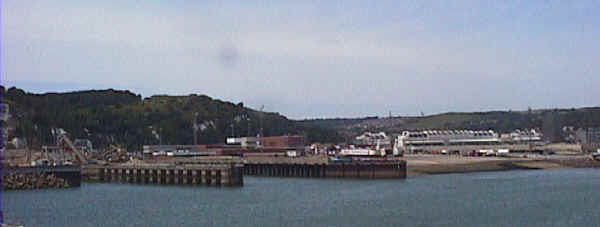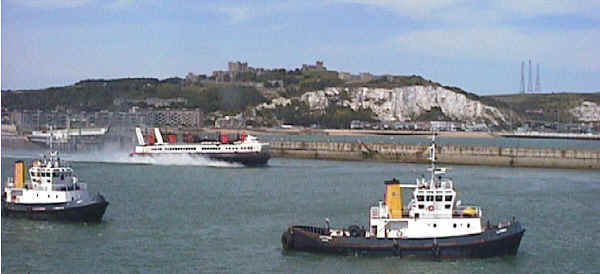| |
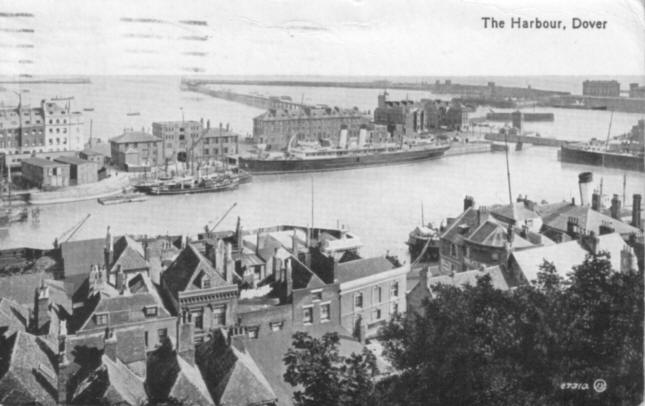
The postcard above was posted on 31st
July 1917. The scene would have been taken before the outbreak of war.
It was taken from the cliffs overlooking Snargate Street and Northampton
Street.
On the far right of the picture can be
seen the Lord Warden Hotel with its elevated walkway to the Dover Town
Station.
"All these harbour schemes came to naught, and Dover, which had
been on the tiptoe of expectation all that time, growing tired of waiting
for outside aid, Sir William Crundall, who was then beginning to exercise
a controlling influence on the Dover Harbour Board, stirred up that body
to do something, on its own account, to provide deep-water harbour
accommodation suited to the wants of the large vessels which now do
the passenger and cargo traffic of the world.
An Act of Parliament was obtained in 1891, for the construction of
the Dover commercial harbour, and a passenger tax was sanctioned to assist
in financing it. the plan designed for this deep-sea harbour outside
the pier heads, was drawn by the late Sir John Coode, consisting of three
parts - (1) the eastern arm, (2) a landing station, and (3) an extension
of the Admiralty Pier to cover the eastern arm. The eastern arm
(since named the Prince of Wales Pier, after the Prince of Wales, now King
Edward VII., who laid the foundation stone), is now completed, adding 75
acres of sheltered water area, the seaward parts of which have about 40ft.
depth at low water, serving for berthing the largest liners which cross
the Atlantic, bringing an entirely new branch of traffic to Dover."
(J.B.J. 1907)
|
|
The Commercial Harbour is shown on old maps as the area
bounded by the Admiralty Pier to the west and the Prince of Wales Pier to the east.
The
picture at the top of the page shows the North and South piers, which flank the entrance
to the inner, or tidal, harbour and the Basins. The North Pier (right of centre)
used to be open to the public and was accessed from underneath the Prince of Wales Pier.
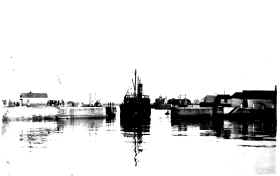
Entering the Inner Harbour through the Crosswall
When the International Hoverport was built, the open ironwork structure of the Prince
of Wales Pier was filled in with concrete and the North Pier became inaccessible.
The landing pad for the hovercraft can be seen to the right of the picture, the red brick
buildings in the centre forming the main part of the complex.
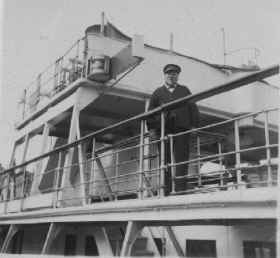
Captain William Sharp (Rtd)
Ocean-going liners have called at the port for decades, but were unable to enter the
harbour. Instead, a tender would go out to meet them and transfer passengers to and
from the pier. The picture above shows my great grandfather after his retirement
from the Harbour Board tugs, when he worked as a watchman on the liner tender (I think
this was the Lady Saville, but I'm sure someone will be able to put me right if
not). This photograph would have been taken in the 1940s, as he died in 1948.
The picture at the bottom of the page shows a hovercraft leaving the port. The
white cliffs and Dover Castle can be clearly seen in the background.
Today, the main focus of this part of the harbour is on pleasure craft - the inner
harbour and basins have all been turned into a yachting marina and the Admiralty Pier
ferry moorings now play host to cruise liners from Norway and the Mediterranean. |
To the left of the South Pier is where once stood the train
ferry dock. Here vessels such as the Shepperton, Hampton and Twickenham
ferries would be manoeuvred into a small dock to embark and disembark goods and
passenger trains to and from the Continent. The pier across the centre of the bottom
picture is the Prince of Wales Pier. My grandfather and great grandfather both
served on the Harbour Board Tugs, Lady Brassey and Lady Duncannon, which
used to tie up alongside the pier, near the lighthouse.
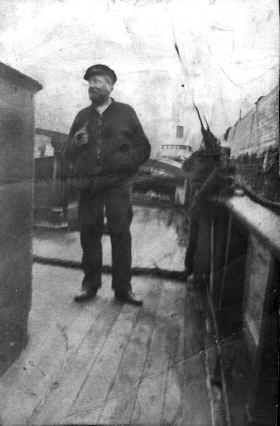
Captain William Sharp
This picture shows my great grandfather, Captain William George Sharp, on the deck of
one of the Dover Harbour Board tugs alongside the Prince of Wales Pier; its sister ship
can be seen in the background. The son of a sea captain, he worked for the Harbour
Board for 54 years, retiring just before WW2, and was Captain on the Board's vessels Lady
Brassey, Lady Duncannon and Dapper, finishing his career on a
salvage ship.
His son (my grandfather), also William George, followed in his footsteps at the age of
17, serving on both the Lady Brassey and the Lady Duncannon. He
was master of the Empire Joan for a short time in 1943 and ended his service on
the hydrographic survey launch.
Although I love the sea, I never felt the urge to follow my ancestors into the
seafaring life, although my daughter worked briefly for P&O.
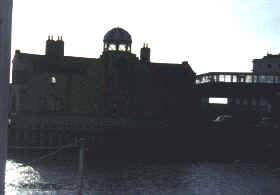
The Custom House
|

